
Use kosher salt and save. Inexpensive kosher salt is not only tastier than regular table salt, but it’s also more frugal. Why? Each flake or crystal of kosher salt is far bigger than its table-salt cousin, meaning that a single pinch will go a very long way, saving you dough in the long run. (One box lasted one of our interviewees over a year.)
One is better than two. Share a sandwich with a friend when you’re out and about and grabbing a quick lunch. One big sandwich costs less than two small sandwiches, so split the sandwich as well as the cost, and save!

Bring it from home. C’mon . . . bet your fridge is filled with assorted leftovers (ours is!). Why spend $5 for a mediocre sandwich from a deli when an inexpensive loaf of bread can be a vehicle for something you truly love?
Raise and lower to heat and cool. Save money on heating and cooling costs by using your shades and drapes strategically. In the summer, keep your shades and drapes closed on the sunny side of the house during the day and open at night. In the winter, keep them open during the day and closed at night.
Stretch your shampoo. You already know you should stock up on your favorite shampoo when it’s on sale. What you may not know: you can alternate using your more expensive brand with a generic brand, and your hair will still look great.
Pump up the savings. Shampoo and conditioner bottles dispense more than you need. Pour these products into large pump bottles—they’ll dole out smaller amounts so your hair care products will last longer.
Concentrate and save!
Most shampoos made today are super-concentrated. When you’re nearing the bottom of the bottle, fill it halfway with water, tighten the cap, and shake. Depending on the product, you may have a few days to a few more weeks of shampoos ahead of you.
Add up the savings. Whether you’re shopping by catalog or on the Internet, find a friend who wants merchandise from the same retailer and place a single order, then split the shipping fees. Better yet, find several friends and place a big order so you get free shipping.
Join Project SOS: Save Our Shoes. Double or triple the life of your shoes by repairing them, resoling them, and reheeling them when necessary. Why buy a new pair of shoes when you can save your favorite old pair with new soles for $20 to $50? And don’t forget that a shoe repair shop can fix luggage, belts, and purses, too.
Keep ’em clean. Watch WD-40 work double duty: it cleans shoe leather and lubricates it so your shoes last longer. Ditto purses, briefcases, wallets, belts, riding saddles, bicycle seats, leather car interiors, and leather furniture. You get the point!
Preventive shoe care. Place foam insoles into all your shoes to save their insides. Buy inexpensive store-brand insoles, and replace them when they become dirty or worn. You’ll save money on new shoes, and you’ll have more comfortable shoes as a perk.
Go with the (low) flow. Invest in a low-flow showerhead, and save on water and heating costs. By spending $10 to $20 on a new showerhead, you can save about 7,300 gallons of water and $30 to $100 each year on your water and heating bills.
Dispense some soap and some savings. Don’t just refill your soap dispenser with soap. Add one part hand soap and three parts water for a soap that cleans without cleaning out your wallet.
Go the old-fashioned body wash route. Instead of using a separate bar soap for your body and one for your face, buy an old-fashioned liquid body wash, such as pure castile soap—a tried-and-true multipurpose favorite that’s not only frugal, but also delightfully pure!
Getting dressed has never been so easy. Buy same-color socks in bulk. If the dryer eats one, you have an automatic match in your dresser drawer—and you won’t need to buy a new pair of socks. Besides, you’ll pay less buying packs of socks rather than individual pairs.
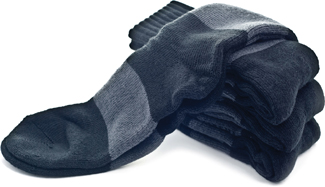
Make your own. No, we’re not kidding. Instead of buying chemical-packed flavored orange, grapefruit, or cherry soda, combine a splash of fresh juice with inexpensive club soda. Cheaper and healthier, by far.
Spice up your life for less. Never buy name-brand dried spices in the grocery store: you’re paying for the bottles they’re packed in. You can often buy spices in bulk at natural foods stores or ethnic groceries, or visit online spice suppliers such as kalustyans.com or penzeys.com. Buy spices you use infrequently in smaller quantities. Store away from light in glass or metal containers.
Dry your own herbs for savings and flavor. Have a leftover bunch of parsley (or cilantro, rosemary, or basil) in your fridge? Don’t throw it away: dry it. Put the leaves on a clean baking sheet and place in a very low oven (200°F) for 30 minutes. Remove, crumble, and store in an airtight jar, out of direct sunlight.
Microwave your sponge. Make sure your sponge contains no metal fibers, and, if it doesn’t, put your wet sponge in the microwave for one to two minutes on full power. You’ll kill the bacteria that would normally make you toss the sponge. You’ll use each sponge longer.
Make an exchange. Look for school and community organizations that offer sporting goods swaps. You can also find sports stores that sell perfectly good secondhand athletic equipment, such as skis, for great prices.

Freeze your hose. Panty hose, that is. Fill a plastic bag with water, drop in your new stockings, zip up the top, and toss the bag in the freezer overnight. Thaw the concoction at room temperature. You’ll strengthen the fibers in the stockings, cut down on runs, and save the cost of additional pairs of hose. You can continue protecting your stockings by refreezing them once a month, without water, for one night.
Make Santa work all year. Buy stocking stuffers that aren’t overtly seasonal at half-off after Christmas, and you can use them as small Valentine’s gifts, in Easter baskets, or as party favors throughout the year.
Store it well and save. Whether it’s food, sweaters, or garden tools, it pays to keep what you own stored carefully to avoid spoilage, moth damage, or rust. Double- and triple-wrap cold food items before freezing to prevent freezer burn; store sweaters in sealed plastic containers to prevent visitations from winged creatures; wipe down your garden tools with rubbing alcohol, dry them, and hang them until next year.
How long should your appliances last?
Check out the average life span (in years) of your:
Refrigerator/freezer
• Side-by-side: 14
• Top-mount: 14
• Bottom-mount: 17
• Single-door: 19
• Compact (dorm type): 5
Range
• Electric: 17
• Gas: 19
Dishwasher: 10
Stay small. Use small pots on small burners to save money on gas or electric costs. If you use a 6-inch pan on an 8-inch burner, you’ll waste more than 40 percent of the energy. If you need to use a bigger pot, be sure to use a bigger burner; the pot won’t heat evenly if you use it on a smaller one.
Cook on top. Your stove uses less energy than your oven, so try cooking meals on the stove as much as possible. Better yet, use a toaster oven, microwave, slow cooker, or pressure cooker.
Use elbow grease, not abrasives. If a spill has had a chance to dry out and cook for a while, use a sponge along with a solution of dishwashing liquid and warm water or a 50-50 solution of vinegar and warm water. An all-purpose cleaner such as Fantastik is fine to use, but don’t give in to the temptation to grab that can of abrasive powder—you’ll scratch the surface. The next spill will grip the scratches and be even harder to remove.
Look for a blue flame. If the gas flame on your stovetop burners is blue, they are working at top efficiency. If the flame is yellow, the burners are working inefficiently, and they should be adjusted by a service technician.
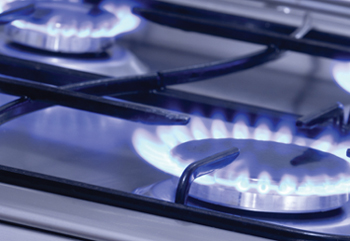
Prevent boilovers. When cooking, use pots and pans that are deep enough to prevent boilovers and splattering. Minimizing spillage will minimize cleanup work and help prolong the life of your stove.
Clean spills quickly. Get in the habit of wiping down your stovetop after every use—your stove will gleam like new for decades, and you’ll save yourself plenty of scrubbing.
Fix enamel chips. If the enamel on your stove gets chipped, touch it up with a porcelain enamel repair kit that you can buy at your appliance store. Be smart, and do it before the damaged spot becomes rusty.
Scrape with plastic. When food splatters on the heating element of your gas oven, grab the plastic ice scraper from your car to scrape it off. A metal scraper is likely to damage the element.
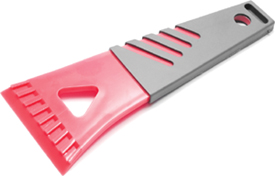
Clean that grimy oven window. A dirty oven window reduces the efficiency of your stove because you keep opening the door to check the food. To clean the window, rub it with a damp cloth dipped in baking soda. If the stuff is really baked on, wipe the window with ammonia, let it stand for 30 minutes, then scrape it off with a plastic ice scraper. Don’t use a metal tool.
Clean the stove parts regularly. Periodically give your stove parts an extensive cleaning. Wash the burner pans and other removable accessories (but not electric burner coils) either by hand in the sink or by running them with your next dishwasher load (if the owner’s manual for your stove says they’re dishwasher-safe). Carefully remove control knobs (usually by pulling straight out) and clean around the knobs’ bases. Wash the knobs in hot, soapy water, rinse, and dry before replacing them.
Clean under the hood. If your stove doesn’t have a sealed cooktop, food and grease will fall down under the burners. So remember to lift the cooktop (like lifting the hood of a car) to clean beneath it. Follow the owner’s manual instructions for lifting the top without damaging it. Then clean the grease buildup with a sponge and warm, soapy water or a 50-50 solution of vinegar and warm water. Rinse with clean water and a sponge.
Replace burner pans with originals. When burner pans get grimy and stained, they don’t reflect the heat upward (which decreases the efficiency of your stove). Shine them up by rubbing with a paste made from vinegar and cream of tartar. If the pans have become too stained to clean, replace them with original equipment, which you can buy at an appliance store.
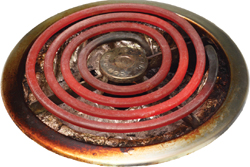
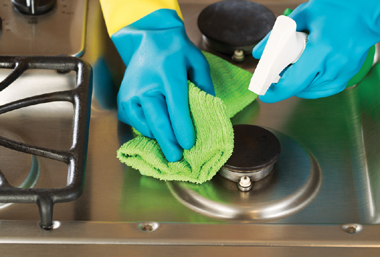
Go easy on the oven door. If you slam it, you may spring the hinge or throw the thermostat out of whack. And don’t rest that casserole on the open oven door—using the door as a shelf is another way to damage the hinge.
Extend the life of your continuous-clean oven. The key to keeping your continuous-clean oven looking great for many years is to be sure to clean up major oven spills promptly before they form a glaze that prevents the interior from burning off minor spills. When you have a major spill, follow these steps:
• Blot up as much of the spill as you can with paper towels. Do this while the oven is still warm and the spill is soft. Don’t rub—any paper particles can clog the rough surface.
• When the oven is completely cool, spray it with an all-purpose cleaner. Work the cleaner in with a nylon-bristle brush or net pad, let stand for about 30 minutes, then scrub with the brush.
Don’t lay foil on the racks. Don’t try to keep your oven clean by laying aluminum foil on the bottom or on the racks. Air needs to circulate freely throughout the oven in order for food to cook efficiently. Also, the foil reflects heat, which can throw off the thermostat.
Burn the coils clean. Heating coils on an electric range usually don’t need washing. Instead, turn them on high to burn off spills. If a spill is massive, wipe up as much as possible after the coil has cooled and then burn off the rest.
Give your microwave a drink. Put a glass of water (add a few slices of lemon for extra deodorizing power) in your microwave and heat it on high for about a minute, until the inside of the microwave is steamy. Let the water sit in the steamy microwave for about 20 minutes. This will loosen all the food particles and begin to dissolve stains. Wipe the inside of the microwave with a paper towel, and you’re done.